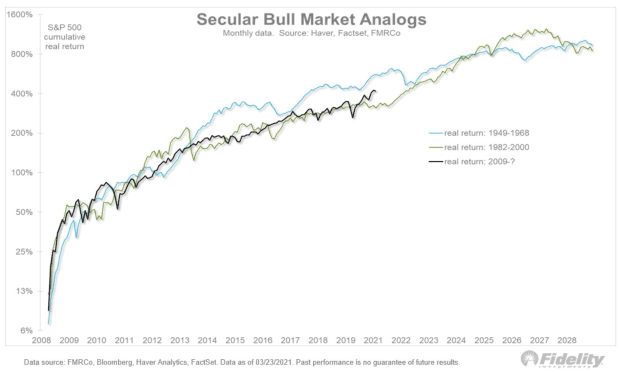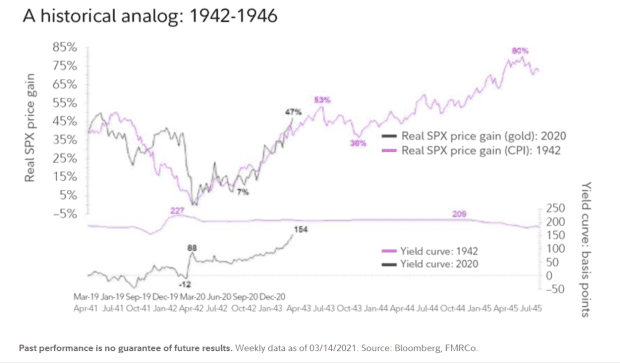Powell and Yellen’s game plan is evocative of the World War II playbook. Here’s what happened then.
Day one of the joint appearance from Federal Reserve Chair Jerome Powell and Treasury Secretary Janet Yellen on Capitol Hill didn’t surprise anyone, but did lay out the current blueprint for U.S. economic policy. Monetary policy will be loose until there is “maximum employment,” and fiscal policy will be aggressive, though Yellen made clear that the White House wants to pay for increased infrastructure investment with higher taxes.
Jurrien Timmer, director of global macro for Fidelity Investments, says fiscal and monetary policy “will remain at full throttle for some time to come.” When this column last heard from Timmer, he was saying that the 1960s provide a blueprint for what’s to come for the stock market. He updated that chart to show it is still on track.

But another historical analog is the 1941 to 1946 period. To mobilize against World War II, federal debt tripled, the Fed’s balance sheet swelled by 10-fold and the Fed capped both short- and long-dated interest rates below the rate of inflation. Granted, the current playbook isn’t quite that aggressive — the Congressional Budget Office’s forecast for the national debt in 2030 is only 6% higher than it was before the COVID-19 pandemic — but directionally it is similar.

“The net result of the Fed’s rate suppression in the 1940s was that real rates fell well below zero and stayed that way for a number of years as inflation took root. In my view, the Fed today will accept higher inflation, as will the Treasury. How else is the country going to get out from under its rising debt burden,” says Timmer.
The result was a surging and broad-based stock market, at least until inflation got really carried away later in the decade. There also was a steeper yield curve, as measured by the gap between 2- and 10-year yields.
Day two on Capitol Hill for Powell and Yellen
Powell and Yellen will be speaking on Wednesday in front of the Senate Banking Committee. In a busy day on the economics front, there are data on durable-goods orders and flash readings of purchasing managers indexes, and also four other Fed officials speaking.
A massive cargo ship is stuck in the Suez Canal, blocking traffic on a key shipping route.
GameStop GME,
Microchip maker Intel INTC,
Electric-vehicle maker Tesla TSLA,
Software maker Adobe ADBE,
Hall of Fame Resort & Entertainment HOFV,
Stock futures higher
Looking more hopeful after a rough day on Tuesday, in which the small-cap Russell 2000 RUT,
Oil futures CL.1,
Random reads
Heavy rains have created waterfalls off the famous Uluru landmark in Australia.
Three dolphins took a New York City tour, swimming in the East River.
Need to Know starts early and is updated until the opening bell, but sign up here to get it delivered once to your email box. The emailed version will be sent out at about 7:30 a.m. Eastern.
Want more for the day ahead? Sign up for The Barron’s Daily, a morning briefing for investors, including exclusive commentary from Barron’s and MarketWatch writers.



